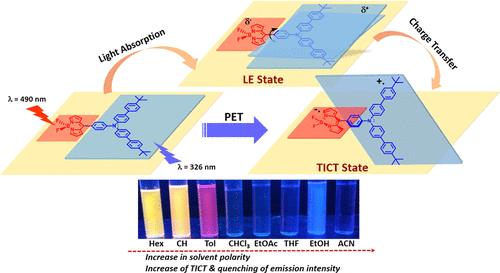当前位置:
X-MOL 学术
›
J. Phys. Chem. A
›
论文详情
Our official English website, www.x-mol.net, welcomes your feedback! (Note: you will need to create a separate account there.)
Excitation-Wavelength-Dependent Light-Induced Electron Transfer and Twisted Intramolecular Charge Transfer in N,N-Bis(4′-tert-butylbiphenyl-4-yl)aniline Functionalized Borondipyrromethenes
The Journal of Physical Chemistry A ( IF 2.9 ) Pub Date : 2020-11-11 , DOI: 10.1021/acs.jpca.0c04789 Suneel Gangada 1 , Ramya Athira Ramnagar , Akanksha Ashok Sangolkar 2 , Ravinder Pawar 2 , Jagadeesh Babu Nanubolu , Partha Roy 1 , Lingamallu Giribabu 3 , Raghu Chitta 1, 2
The Journal of Physical Chemistry A ( IF 2.9 ) Pub Date : 2020-11-11 , DOI: 10.1021/acs.jpca.0c04789 Suneel Gangada 1 , Ramya Athira Ramnagar , Akanksha Ashok Sangolkar 2 , Ravinder Pawar 2 , Jagadeesh Babu Nanubolu , Partha Roy 1 , Lingamallu Giribabu 3 , Raghu Chitta 1, 2
Affiliation

|
A series of bis(4′-tert-butylbiphenyl-4-yl)aniline (BBA) functionalized borondipyrromethene (BODIPY) dyads, Dyads 1–3, containing the BBA group tethered to BODIPY moiety either directly or through a phenyl or alkynyl phenyl spacers are synthesized, and the light-mediated charge transfer within the chromophores has been systematically investigated. The crystal structure of Dyad-1 showed a tilt of 44.2° between the BODIPY and BBA molecular planes and intermolecular C–H···π interactions with these moieties. Cyclic voltammetric and computational studies showed that the BBA moiety can act as the electron donor (D) and BODIPY as the electron acceptor (A) and the optical absorption studies revealed that an increase in the conjugation of the linker from Dyad-1 to Dyad-2 resulted in bathochromic shifts. Steady-state fluorescence studies involving photoexcitation of the BBA moiety at 326 nm resulted in the decrease in fluorescence intensity of the BBA, indicating the possibility of sequential occurrence of faster photoinduced energy transfer (PEnT) followed by the photoinduced electron transfer (PET) or solely PET within the dyads, and the driving forces of the charge separation were calculated to be exothermic in all of the employed solvents. Parallel time-resolved fluorescence experiments involving the excitation of BBA moiety also supported the occurrence of charge separation in these dyads. Interestingly, excitation of the BODIPY moiety of Dyad-1 and Dyad-2 at 490 nm in solvents of increasing polarity leads to a red-shifted BODIPY emission with weakened intensity. This spectral behavior indicated the occurrence of emission from the locally excited (LE) state in nonpolar solvents, whereas formation of an LE state followed by the rotation of the chromophores at the D–A bond leads to a low energy twisted intramolecular charge transfer state (TICT), resulting in a charge-separated state BBA+•–BODIPY–• in polar solvents. Furthermore, the hydrophobicity studies involving the solutions of dyads in admixtures of polar tetrahydrofuran (THF) and nonpolar hexanes revealed that when the fraction of hexanes in these mixtures is increased, the emission of BODIPY moiety was observed to be blue-shifted and exhibited enhanced intensity supporting the occurrence of TICT in these dyads.
中文翻译:

N,N-双(4'-叔丁基联苯-4-基)苯胺官能化双吡咯烷酮中基于激发波长的光诱导电子转移和扭曲分子内电荷转移
一系列的双(4'-叔-butylbiphenyl -4-基)苯胺(BBA)官能化硼二(BODIPY)二价基,二元组1 - 3,将含有BBA团直接或通过一个苯基或炔基苯基间隔件拴BODIPY部分任合成,并已系统地研究了生色团内的光介导的电荷转移。Dyad-1的晶体结构结果表明,BODIPY和BBA分子平面之间的倾斜度为44.2°,并且与这些部分的分子间C–H··π相互作用。循环伏安和计算研究表明,BBA部分可以充当电子给体(D),BODIPY充当电子受体(A),并且光吸收研究表明,连接子从Dyad -1到Dyad-的共轭作用增加。2导致红移。涉及在326 nm处对BBA部分进行光激发的稳态荧光研究导致BBA荧光强度降低,这表明有可能依次发生更快的光诱导能量转移(PEnT),然后是光诱导电子转移(PET)或单独发生计算出二元组中的PET和电荷分离的驱动力在所有使用的溶剂中都是放热的。涉及BBA部分激发的并行时间分辨荧光实验也支持在这些二元组中发生电荷分离。有趣的是,激发Dyad-1和Dyad-2的BODIPY部分在极性增加的溶剂中在490 nm处产生的红移BODIPY发射强度减弱。这种光谱行为表明在非极性溶剂中发生了从局部激发(LE)态发射的光,而形成LE态并随后在D-A键上生色团的旋转导致低能扭曲的分子内电荷转移态( TICT),从而产生电荷分离状态BBA +• – BODIPY –•在极性溶剂中。此外,疏水性研究涉及在极性四氢呋喃(THF)和非极性己烷的混合物中的二联体溶液,发现当这些混合物中己烷的比例增加时,BODIPY部分的发射被观察为蓝移并显示出增强的强度。支持在这些二元组中出现TICT。
更新日期:2020-11-25
中文翻译:

N,N-双(4'-叔丁基联苯-4-基)苯胺官能化双吡咯烷酮中基于激发波长的光诱导电子转移和扭曲分子内电荷转移
一系列的双(4'-叔-butylbiphenyl -4-基)苯胺(BBA)官能化硼二(BODIPY)二价基,二元组1 - 3,将含有BBA团直接或通过一个苯基或炔基苯基间隔件拴BODIPY部分任合成,并已系统地研究了生色团内的光介导的电荷转移。Dyad-1的晶体结构结果表明,BODIPY和BBA分子平面之间的倾斜度为44.2°,并且与这些部分的分子间C–H··π相互作用。循环伏安和计算研究表明,BBA部分可以充当电子给体(D),BODIPY充当电子受体(A),并且光吸收研究表明,连接子从Dyad -1到Dyad-的共轭作用增加。2导致红移。涉及在326 nm处对BBA部分进行光激发的稳态荧光研究导致BBA荧光强度降低,这表明有可能依次发生更快的光诱导能量转移(PEnT),然后是光诱导电子转移(PET)或单独发生计算出二元组中的PET和电荷分离的驱动力在所有使用的溶剂中都是放热的。涉及BBA部分激发的并行时间分辨荧光实验也支持在这些二元组中发生电荷分离。有趣的是,激发Dyad-1和Dyad-2的BODIPY部分在极性增加的溶剂中在490 nm处产生的红移BODIPY发射强度减弱。这种光谱行为表明在非极性溶剂中发生了从局部激发(LE)态发射的光,而形成LE态并随后在D-A键上生色团的旋转导致低能扭曲的分子内电荷转移态( TICT),从而产生电荷分离状态BBA +• – BODIPY –•在极性溶剂中。此外,疏水性研究涉及在极性四氢呋喃(THF)和非极性己烷的混合物中的二联体溶液,发现当这些混合物中己烷的比例增加时,BODIPY部分的发射被观察为蓝移并显示出增强的强度。支持在这些二元组中出现TICT。


























 京公网安备 11010802027423号
京公网安备 11010802027423号